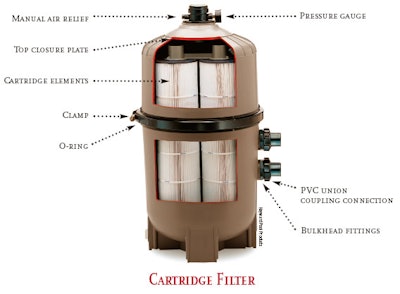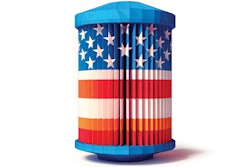
Filters are definitely not the most attractive part of any poolscape. But without one, every pool would be a murky mess. Hence, keeping them clean and in good condition is absolutely necessary in order to maintain crystal clear water.
And while servicing filters may not be any tech's favorite chore, it must be done, and it's important to be familiar with the inner workings of each type of filter so it can be done safely and correctly. Toward that end, with the help of a few industry experts, AQUA put together a guided primer that details a few of the most noteworthy components on sand, D.E. and cartridge filters. Please note the three suppliers consulted for this article all make cartridge, D.E. and sand filters. AQUA's intent is not to endorse any particular filter brand or model; the goal is to provide useful information.
Cartridge Filter
Pressure gauge: This feature, which every filter has, indicates when a filter needs to be cleaned or backwashed, which is generally when the pressure rises 7 to 10 psi over the starting pressure.
Manual air relief: A valve that bleeds air with a quick quarter turn of the lever, this is an important safety feature that, again, every filter has. "We always tell people, 'Before you attempt to clean or change a cartridge, shut the filtration system off and turn this knob a quarter of a turn. Then leave it open until all the air is out, which is until you see a steady stream of water, not a combination of air and water,'" says Mark Normyle, filters product manager for Hayward Pool Products. "Once you see a steady stream of water, you know all the air that may have gotten trapped inside the filter is purged. Generally, what happens is if someone has a small leak in their system, air gets into the tank and as you know, air compresses and you don't want to open a tank with compressed air."
Top closure plate: "That plate holds the cartridge elements in place and prevents them from becoming disconnected and allowing unfiltered water back into your pool," says Normyle.
Cartridge elements: These are made of a non-woven polyester and need to be cleaned regularly. Exactly how often they need to be cleaned depends on bather load and other factors affecting the pool, like the weather. Since it's OK to oversize a cartridge filter, many homeowners are going with a large-capacity cartridge filter, since that will lengthen the time between cleanings. And, depending on pool use, pool owners with a large-capacity cartridge filter may be able to go a whole season without cleaning the elements.
Frequently, elements only need to be thoroughly cleaned with water and a hose equipped with a high-pressure nozzle. However, when a chemical treatment is necessary, there are two things that can build up on the element, oils and/or calcium, and they're treated differently. Says Sue Robach, national trainer for Pentair Water Pool & Spa, "If there are oils in the pool, we want to degrease it first, and then we want to remove the dirt and calcium with some type of acid product. The reason for that is if we don't remove the oils first and we do an acid treatment on the cartridge, we set the oil into the fabric and that shortens the life of the filter cycle."
Though not always available with an initial filter purchase, cartridge elements impregnated with Microban are now available in the aftermarket, says Normyle. "What the material does is it inhibits the growth of mold on the element, but it will not kill anything in the water. It just prevents mold and mildew from culturing on the element."
Clamp: "This holds the two halves of the vessel together under pressure, so it's very important that people follow the instructions step by step for purging the air out of the tank," says Normyle. "Also, be careful not to twist the clamp, and when you reassemble it, we recommend you take a mallet and tap it all the way around and then secure it per the instructions."O-ring: "Whenever you're servicing the filter, you always want to take a look at the O-ring and it certainly doesn't hurt to add some lube to it when you're servicing," says Gary Ortiz, engineering manager for Hayward Pool Products. "A lot of times what will happen is when you take the clamp off and remove the top to clean your elements, obviously your system is off, but the tank is still filled with water. That water, once you separate the head from the body, will be carrying dirty water and pouring it out of the tank, and sometimes that dirty water with bugs and hair just pours out and gets on your O-ring. So it's always a good thing to take it off and wash it off, throw a little more lube on there, and set it back in place once you clean your elements. It's just a good preventative maintenance kind of thing to do."
Bulkhead fittings: "These are a neat feature to have because they allow you to hard plumb up to the filter," says Ortiz. "And if you need to remove your filter from your pad for whatever reason, instead of having to cut plumbing or make any permanent cuts and having to re-glue and repipe, there are union nuts that you just unscrew from the filter and the filter separates from your plumbing system."
PVC union coupling connection: Like many filters today, this one accepts both 1.5- or 2-inch PVC. "It's convenience," says Ortiz. "You don't have to worry about putting in any extra coupling and it makes installation easier."
D.E. Filter
Internal air relief: "This safety feature actually protrudes into the flow of water and functions like a venturi," says Frank Swindell, product manager for filters for Pentair Water Pool and Spa. "So you want this internal air relief to be as high in the tank as possible so if any air while your system is running does collect in the filter, it will be sucked through this air relief and will go back out into the pool and won't gather in the filter. You still want to open the manual air relief in case this internal air relief gets plugged up."
Upper manifold: "This is where all of your now clean water that has gone through the grids is captured to direct it back to the valve and then to the pool," says Swindell.
Manifold tie rods: "These two rods secure your top and bottom manifold and squeeze the grids to hold them in there," says Swindell. "And that's got to be tight enough to keep your grids in the manifold, but you don't want to overtighten because you'll crack the grids. In our particular setup, we've made it so you can't because it's not a complete threaded rod. It's a rod with threads at the top and the bottom and we only have x number of threads, so when you tighten it all the way to the end of the thread, you still haven't crushed your skeleton."
Stand pipe O-ring: Often filters have other O-rings in addition to the one that helps seal the tank top and bottom. For instance, this filter has an O-ring between the manifold and the top pipe. "There's an O-ring on top of that pipe that actually seals, and on a D.E. filter, it's very important that your seals are good and tight because D.E. powder wants to find every little crevice, and when it does, it ends up back in your pool," says Swindell.
Grids/plastic skeleton: "These grids are coated with the D.E., which is really what does the cleaning," says Swindell. "When the filter is backwashed, the grids are cleaned, but to really get a total clean, once a year you should take the grids out and completely take the grid assembly apart and hose off the grids. It's very important that when you take it apart and clean it, you look for any tears and ripped seams because the D.E. powder is very fine and if it's got a tear, D.E. powder will end up in your pool, which is not wanted. That's something you want to look at least once a year to make sure your elements are in good shape. And grids typically have a two- to three-year lifespan."
When cleaning the D.E. filter, also note the condition of the plastic skeleton. "The plastic skeleton that's inside of that sometimes over time gets brittle, so you want to make sure you've got a good, rigid skeleton underneath," says Swindell.
After a D.E. filter is backwashed or taken apart and cleaned, the D.E. must be recharged. "It's very important that a D.E. filter is not run without D.E. because oils in the water could penetrate the cloth and cause it to have abnormally short cycles," says Swindell.
Clamp band: "You want to make sure the clamp band is tight and secure," says Swindell. "On our clamp we have a little spring, and when you tighten it to the proper point, all the coils of the spring are touching, so that's sort of a visual safety guide."
Sand Filter
Diffuser: "The diffuser is the filter inlet and its main function is to distribute the water evenly over the surface of the sand bed," says Steve Gutai, product manager for pumps, filters and valves at Jandy Swimming Pool Products. "Diffuser design can change depending on tank design. Some sand filters have multiple diffusers, others have one diffuser in the upper, center portion of the tank (see sand filter diagram on pg. 80), and finally, others have a diffuser that is connected to the bottom portion of a top-side multi-port valve. All of these have the same goal: distribute the water flow evenly over the sand bed surface."
Freeboard area: "You want to use as much of the surface area of the sand bed as possible," says Gutai. "The freeboard area is where the distribution of the incoming water takes place. It allows for the even distribution of the water over the surface of the sand bed."
Sand: Depending on usage, sand can last up to 10 years. However, says Swindell, "If you properly take care of the sand, your filtering media is permanent. You never have to change it, and if you do have problems with your sand bed, you really only have to replace the top 1 to 2 inches of the sand bed." If the sand bed is not properly cared for and you do have to change the whole thing out, set aside a good chunk of time, since there will be a couple hundred pounds of sand to get out of the tank. When you add the new sand, fill the bottom of the tank with some water before adding the sand to protect the laterals.
Unions: "Unions make it easy to disconnect and service a sand filter or filter of any type," says Gutai. "The majority of filters sold on the market have unions. This follows the same current trend with swimming pool pumps."
Laterals: "The laterals essentially pull the water evenly through the sand bed, sending it to the outlet of the filter," says Gutai. "During the backwash cycle, the laterals become the inlet on the bottom of the tank and the diffuser becomes the outlet. In the backwash mode, the laterals inlet water into the bottom portion of the sand bed. This stirs up the sand bed and sends the top few inches into solution, resulting in the debris being flushed out to waste in the backwash cycle."
How Do I Choose?
Each filter has its own distinct advantages and disadvantages, so how you choose one depends on how clear you need the water to be and how much time and energy you want to devote to the filter.
Steve Gutai, product manager for filters and pumps at Jandy Swimming Pool Products, says, "Sand filters are very good for areas where there's a high amount of dust in the air, where you have to constantly flush the filter."
The downside to sand filters is you lose a lot of water when you backwash, which can be a problem in areas where water is scarce. In addition, these filters only remove particles as small as 25 to 50 microns. "The water just never looks as clean and crystal clear as it does with a D.E. or cartridge filter," says Gutai.
On the other end of the spectrum, D.E. can filter out particles as small as 3 to 5 microns. "Water filtered with D.E. is absolutely the most clear water you can get, and that's important to people who really want to show their pools," says Frank Swindell, filters products manager at Pentair Water Pool & Spa. "In the daytime, when the sun is shining, 99 percent of people would never be able to tell the difference between a D.E., cartridge and sand pool right next to one another because it's not that noticeable. When it is noticeable is if you're swimming in a pool with goggles on and you see the little particles floating around in the water. Also, at night when the pool is nice and calm and there's no ripples on the pool and you've got a light in it and on, then you can really see the smaller particles a sand filter won't capture."
This clarity comes at a price, though. D.E. filters often require the most time and effort to service and clean. For example, when a D.E. filter get s backwashed, you have to re-charge the filter with D.E. In addition, D.E. in most municipalities cannot just be dumped into the street, so you'll need a pea trap or some other type of reclamation tank to capture the D.E. And once or twice a year, the filter should be taken apart and thoroughly cleaned, and that's usually a time-consuming, messy job.
Cartridge filters don't get pool water quite as crystal clear as D.E. filters since they filter particles as small as 10 to 15 microns. But they are a lot easier to maintain than D.E. filters, and there's no backwashing involved in cleaning them. Plus, depending on usage, some of the largecapacity cartridge filters on the market allow homeowners to go a whole season before having to clean the elements.








































